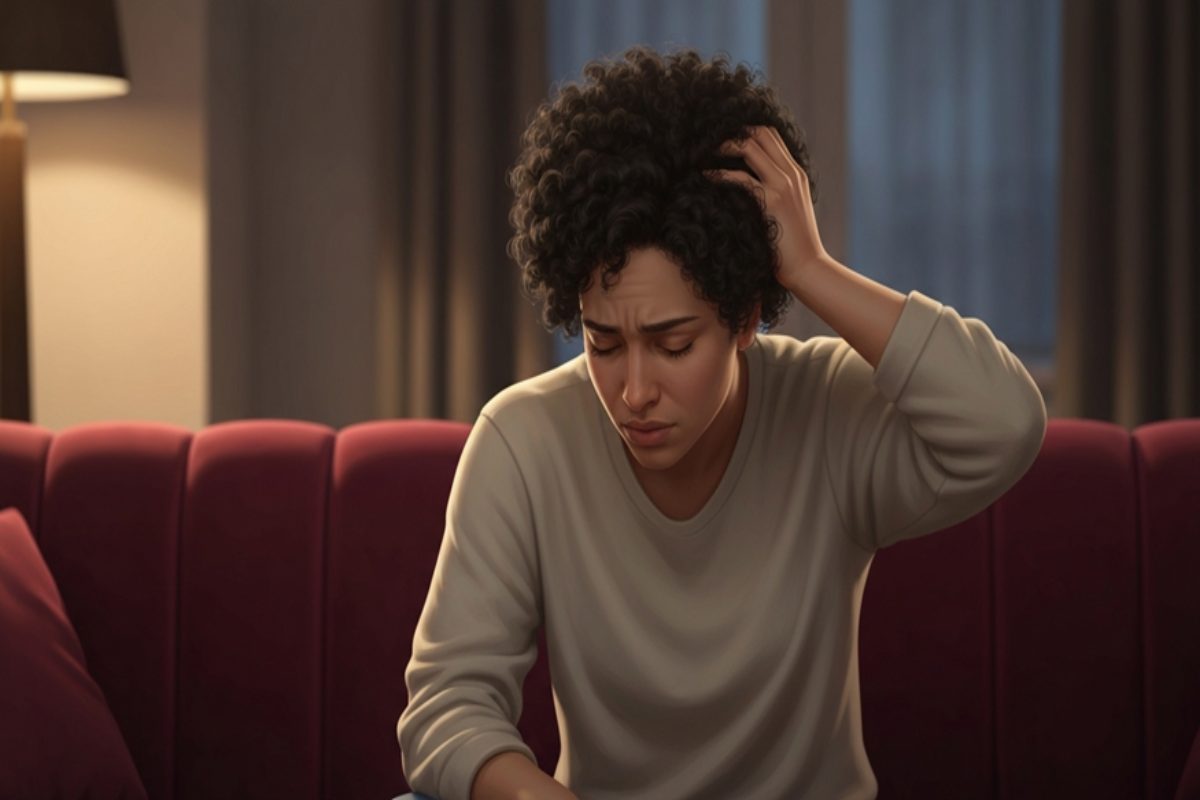Key Highlights
Headache in back of head – Pain in the back of the head is most often caused by tension headaches, which are very common.
- Other causes include issues like occipital neuralgia, where nerves in your neck are irritated.
- Poor posture and muscle strain in your neck are significant triggers for this type of headache.
- While most cases are not serious, sudden, severe pain may require medical attention.
- You can find pain relief through home remedies, lifestyle changes, and medical treatments.
- Understanding the specific type of headache you have is key to effective treatment.
Introduction
Experiencing a headache in the back of your head can be unsettling, but it’s a common issue. This head pain can range from a dull ache to a sharp, throbbing sensation. While many types of headaches exist, those felt in the back of the head often have specific causes, such as muscle tension or nerve irritation. Understanding the source of your headache pain is the first step toward finding lasting relief and improving your overall well-being.
Overview of Headache in the Back of the Head
When you feel pain in the back of your head, it’s often due to a tension headache. This is a very common type of headache and usually isn’t a sign of a serious problem. The discomfort might feel like a tight band around your head, and it can be triggered by stress, fatigue, or poor posture.
While frequent, this headache pain can disrupt your daily routine and affect your quality of life. Pinpointing what triggers these headaches is essential for managing them effectively. Distinguishing them from other headache types is also crucial for finding the right treatment.
What distinguishes headaches in the back of the head from other types
Headaches felt in the back of the head often originate from issues in your neck or the base of your skull. Unlike migraine headaches that typically cause throbbing pain on one of the sides of the head, these headaches are frequently linked to muscle tension, nerve irritation, or problems with your cervical spine.
Tension headaches, a common cause of pain in the back of the head, feel like a constant pressure or a tight band. This is different from the sharp, shooting pain of occipital neuralgia or the pulsating pain of a migraine. The location and quality of the pain are key clues to identifying the specific type of headache you’re experiencing.
Understanding these differences is important because the treatment for various headache disorders can vary greatly. What works for a tension headache might not be effective for other headache types, making a correct diagnosis essential for relief.
Common symptoms linked to pain in the back of the head
The head pain you feel in the back of your head is often just one piece of the puzzle. It’s frequently accompanied by other headache symptoms that can help identify the underlying cause. For instance, you might notice that the pain gets worse when you move your neck.
Many people also experience neck pain or a stiff neck along with the headache. This combination strongly suggests that the issue might be related to your neck muscles or spine. In some cases, the pain can be more than just an ache.
Other common symptoms that may accompany this head pain include:
- A feeling of tightness or pressure around your head
- Sensitivity to light or sound
- Dizziness or visual disturbances
- Pain that radiates from the back of the head to behind the ears
Major Causes of Headache in the Back of the Head
Several factors can lead to pain in the back of the head. The main categories of causes are often related to your neck muscles, nerves, or even your posture. Issues like muscle strain, nerve irritation, and problems with your cervical spine are common culprits.
Identifying the specific cause of the discomfort is the most important step toward finding relief. Whether it’s from sitting at a desk all day or an underlying condition, understanding the root of the problem will guide your treatment plan. We’ll explore some of the most frequent causes in more detail.
Identifying Serious Headaches from Mild Ones
Most headaches in the back of the head are harmless, but it’s important to know when to seek medical advice. If your headache is unusually severe, comes on suddenly, or is accompanied by other concerning symptoms, it could signal an underlying condition that needs attention.
Don’t hesitate to seek medical care if you feel something isn’t right. A healthcare provider can determine if your severe headaches are a sign of something more serious and ensure you get the appropriate treatment. Next, we’ll cover specific warning signs to watch for.
Warning signs that need medical attention
While most headaches are manageable at home, certain symptoms warrant a trip to the doctor. The most significant red flag is a sudden, severe, or “thunderclap” headache, which reaches maximum intensity within a minute. This type of intense pain could indicate a serious issue.
You should also pay close attention to any neurological symptoms that accompany your headache. These can be signs of underlying medical conditions that require immediate evaluation. A headache that follows a recent head injury should always be checked out by a professional.
Seek medical attention if your headache is accompanied by any of the following:
- Fever, rash, or a stiff neck
- Confusion, memory loss, or changes in personality
- Vision changes, slurred speech, or weakness
- Loss of balance or seizures
Differentiating acute from chronic headache conditions
Headaches can be categorized as either acute or chronic, and understanding the difference is helpful. An acute headache is one that appears suddenly and is usually a one-time event, often with a clear trigger like dehydration or lack of sleep.
On the other hand, chronic headaches are frequent headaches that occur on 15 or more days a month for at least three months. If your headaches are becoming a regular part of your life, it’s time to see a doctor. This persistence could point to an underlying cause that needs to be addressed.
You should consult a doctor if your headaches are getting worse over time, not responding to over-the-counter medication, or interfering with your daily activities. A professional can help diagnose the issue, whether it’s an acute problem or a chronic condition, and create a plan for relief.
Key Types of Headaches Felt at the Back of the Head
Pain in the back of the head can stem from several types of headaches. While tension headaches are the most frequent, other headache disorders can also cause discomfort in this area. Each type has unique characteristics and triggers.
Knowing which type of headache you have is crucial for finding the most effective treatment. From nerve-related pain to migraines, let’s look at the features of the key headache types that can cause pain in the back of your head.
Relief Methods and Treatment Options
Finding pain relief for headaches in the back of your head depends on the cause, but many effective treatment options are available. Your approach might include simple home remedies, lifestyle adjustments, or medical interventions.
From over-the-counter pain relievers to specialized treatments like physical therapy, there are many ways to manage your symptoms. The goal is to reduce both the frequency and severity of your headaches. Let’s explore some of the most effective methods for finding relief.
Home remedies and lifestyle adjustments for pain relief
Yes, there are many effective home remedies you can try for pain relief. Simple lifestyle changes can often make a big difference, especially for headaches caused by tension or poor posture. One of the first steps is to identify and avoid your triggers, such as stress or lack of sleep.
Gentle stretching for your neck and shoulders can help release muscle tension. Applying a warm compress to the back of your neck can also relax tight muscles and ease the pain. Additionally, practicing relaxation techniques like deep breathing or meditation can help manage stress levels.
Here are a few more tips for at-home pain relief:
- Stay hydrated by drinking plenty of water throughout the day.
- Ensure you get consistent, restful sleep each night.
- Engage in regular physical activity to improve posture and reduce stress.
- Take breaks from screens to avoid eye strain and neck tension.
Medical treatments, medications, and therapies
If home remedies aren’t enough, several medical treatments can provide relief. Over-the-counter pain relievers like ibuprofen or acetaminophen are often effective for occasional tension headaches. However, be mindful of medication overuse, as it can lead to rebound headaches.
For more persistent or severe pain, your doctor might recommend prescription medications. For occipital neuralgia, treatments like nerve blocks can provide significant relief by numbing the irritated nerves. Physical therapy is also a highly effective option for addressing underlying muscle and spine issues.
Depending on the cause, your doctor may suggest:
- Prescription-strength muscle relaxants or anti-inflammatory drugs.
- Injections such as steroid injections or nerve blocks.
- In rare cases where a structural problem is identified, surgical treatment may be considered.
Conclusion
Understanding headaches in the back of the head is essential for managing discomfort and determining when to seek medical help. By recognizing the distinct characteristics, causes, and types of these headaches, you can better navigate your treatment options. From tension headaches to cervical spine issues, knowing the triggers and relief methods available can empower you to take control of your health. Remember, proactive lifestyle changes and effective pain management strategies can make a significant difference in your daily life. If you have questions or need further assistance, don’t hesitate to reach out for professional guidance.
Frequently Asked Questions
Can sleeping position or posture trigger headaches in the back of the head?
Yes, poor posture and sleeping in an awkward position are common triggers for headaches in the back of the head. These habits strain your neck muscles, leading to tension and a stiff neck. Maintaining good posture and using a supportive pillow can help prevent this type of pain.
When should I consult a doctor for recurring pain in the back of my head?
You should seek medical care if you experience frequent or severe headaches, if the headache pain worsens, or if it’s accompanied by other symptoms like fever or confusion. A doctor can rule out a serious underlying condition and provide proper medical advice for your recurring pain.
How do neck problems contribute to headaches at the back of the head?
Problems in your cervical spine, such as arthritis or disc issues, can irritate nerves and strain neck muscles. This neck pain and tension can then radiate to the back of your head, causing referred head pain. This type of headache is known as a cervicogenic headache.
Also read: How to Get Rid of Mucus in Throat: Effective Remedies


